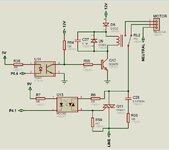gauravkothari23
Advanced Member level 2

Hi All,
I am trying to drive a 120W AC gear reduction motor 220V single - phase speed control motor forward and reverse motor (Image Attached) using MicroController. Have attached a circuit diagram of Motor Driver where i am using a Traic to switch the motor ON and OFF and Relay (OMRON G5LE-14-dc12) to make the motor move in forward and reverse direction.
The problem what i am facing is many a times when making the relay switch ON to OFF or OFF to ON, the relay contact sticks to its position itself and does not goes OFF or ON. it goes ON or OFF only after tapping on the relay. As i am aware that the problem is due to Arching when switching the Relay ON/OFF. but what i have done is
For Example.
if Relay is in ON Position. and when i need to switch the relay in OFF position. i initially switch the Triac OFF, wait for atleast 1 second to get the motor completely OFF, so now there is no current present in the relay and then Make the relay in OFF Position and then Switch the Triac ON again. so i guess in this case the Arching will not take place. so why does the relay sticks to its pole. The motor current i have measured was around 2 Amps at full Load.
I guess i cannot even use snubber for Relay contacts in Both C-NO and C-NC pins. because when any relay contact is open, the snubber would still provide a small amount of current to Motor Capacitor which might make the motor malfunction.
So can anybody please provide me the solution for the same.
I am trying to drive a 120W AC gear reduction motor 220V single - phase speed control motor forward and reverse motor (Image Attached) using MicroController. Have attached a circuit diagram of Motor Driver where i am using a Traic to switch the motor ON and OFF and Relay (OMRON G5LE-14-dc12) to make the motor move in forward and reverse direction.
The problem what i am facing is many a times when making the relay switch ON to OFF or OFF to ON, the relay contact sticks to its position itself and does not goes OFF or ON. it goes ON or OFF only after tapping on the relay. As i am aware that the problem is due to Arching when switching the Relay ON/OFF. but what i have done is
For Example.
if Relay is in ON Position. and when i need to switch the relay in OFF position. i initially switch the Triac OFF, wait for atleast 1 second to get the motor completely OFF, so now there is no current present in the relay and then Make the relay in OFF Position and then Switch the Triac ON again. so i guess in this case the Arching will not take place. so why does the relay sticks to its pole. The motor current i have measured was around 2 Amps at full Load.
I guess i cannot even use snubber for Relay contacts in Both C-NO and C-NC pins. because when any relay contact is open, the snubber would still provide a small amount of current to Motor Capacitor which might make the motor malfunction.
So can anybody please provide me the solution for the same.


